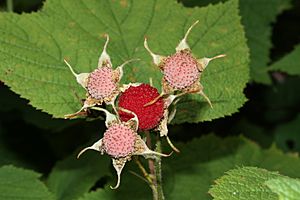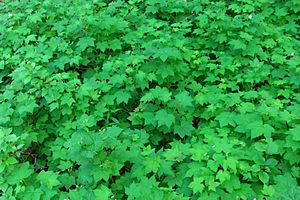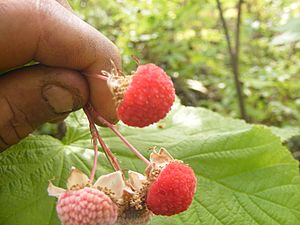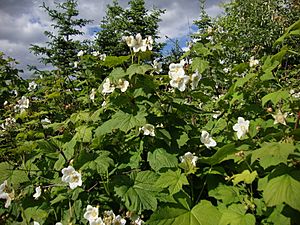Thimbleberry facts for kids
Quick facts for kids Thimbleberry |
|
|---|---|
 |
|
| Conservation status | |
| Scientific classification | |
| Kingdom: | |
| (unranked): | |
| (unranked): | |
| (unranked): | |
| Order: | |
| Family: | |
| Genus: | |
| Subgenus: |
Anoplobatus
|
| Species: |
R. parviflorus
|
| Binomial name | |
| Rubus parviflorus Nutt. 1818
|
|
| Synonyms | |
|
Synonymy
Bossekia nutkana Greene
Bossekia parviflora (Nutt.) Greene Rubacer parviflorum (Nutt.) Rydb. Rubus natkanus G.Don Rubus nutkanus Moc. ex Ser. Rubus nutkanus var. nuttallii Torr. & A.Gray Rubus nutkanus var. parviflorus (Nutt.) Focke Rubus parviflorus var. bifarius Fernald Rubus parviflorus var. grandiflorus Farw. Rubus parviflorus var. heteradenius Fernald Rubus parviflorus var. hypomalacus Fernald Rubus parviflorus subsp. velutinus (Hook. & Arn.) R.L.Taylor & MacBryde Rubus velutinus Hook. & Arn. Rubus ribifolius C.K.Schneid. |
|
The Thimbleberry (scientific name: Rubus parviflorus) is a type of plant that grows in the cooler, temperate parts of North America. It's also sometimes called "redcaps." This plant produces tasty red fruits that look a lot like raspberries, but they are usually shorter and more rounded. Thimbleberries are quite soft, so they don't travel well, which is why you won't often find them in stores. However, they are grown in gardens because they look nice. The plant itself has large, fuzzy leaves and, unlike many other berry plants, it doesn't have any thorns!
Contents
Where Thimbleberries Grow
Thimbleberries are native to western North America. You can find them from Alaska all the way down to California, New Mexico, and even parts of Mexico like Chihuahua and San Luis Potosí. They also grow east into the Rocky Mountains and in some areas around the Great Lakes Region. These plants can grow from sea level in the northern areas up to very high places, about 3,000 meters (around 9,800 feet) above sea level in the south.
Thimbleberry in Nature
You'll often spot thimbleberry plants growing along roadsides, near railroad tracks, and in open areas of forests. They are one of the first plants to grow back after a forest has been cut down or after a forest fire.
Thimbleberries often grow alongside other plants like coastal woodfern, trillium, and Smilacina racemosa.
The fruit of the thimbleberry is a favorite snack for birds and bears. Black-tailed deer also enjoy eating the young leaves and stems of the plant.
What Thimbleberries Look Like
The thimbleberry plant is a thick shrub that can grow up to 2.5 meters (about 8 feet) tall. Its main stems are usually no wider than 1.5 centimeters (about 0.6 inches). These plants often grow in large groups because they spread using underground stems called rhizomes. As mentioned, they don't have any sharp prickles. The leaves are shaped like a hand with five main parts, and they can be as wide as 20 centimeters (about 8 inches). They feel soft and fuzzy. The Concow tribe of Native Americans calls this plant wä-sā’ in their language.
Thimbleberry Flowers
The flowers of the thimbleberry plant are quite large, usually between 2 to 6 centimeters (about 0.8 to 2.4 inches) across. They have five white petals and many pale yellow parts in the center called stamens. Even though the scientific name parviflorus means "small-flowered," the thimbleberry actually has some of the biggest flowers of all Rubus plants!
Thimbleberry Fruit
The plant produces edible fruits that are about a centimeter (0.4 inches) wide. They turn a bright red color in the middle to late summer. Like raspberries, thimbleberries are not true berries. Instead, they are made up of many tiny little fruits called drupelets clustered around a central core. When you pick a thimbleberry carefully, the drupelets can come off, leaving a hollow fruit that looks a bit like a thimble. This is probably how the plant got its name!
How People Use Thimbleberries
Eating Thimbleberries
Thimbleberry fruits are flatter and much softer than raspberries, and they also have many small seeds. Because they are so soft, they don't handle being packed or shipped very well. This is why you won't often see thimbleberries sold in stores.
However, you can eat wild thimbleberries fresh or dried. They can also be made into a delicious jam. This jam is sold as a special local treat in some areas where thimbleberries grow, especially in the Keweenaw Peninsula of Upper Michigan. To make thimbleberry jam, people often mix equal amounts of berries and sugar, then boil it for a couple of minutes before putting it into jars. If you cook the berries without sugar, they have a unique sweet-sour taste and can be kept in the refrigerator for a few days.
Thimbleberries in Gardens
Special plant nurseries grow Rubus parviflorus because it's a beautiful ornamental plant. People use it in regular gardens, in gardens that feature native plants, and in gardens designed to attract wildlife. It's also used in projects that aim to restore natural habitats. The fruit has a lovely smell. You can grow new thimbleberry plants best by planting pieces of their underground stems (rhizomes), or sometimes from seeds or stem cuttings.
The flowers of the thimbleberry plant are great for pollinators, including native bees, honeybees, and bumblebees. The fruit attracts various birds and mammals, including bears. It's also a food source for the caterpillars and adult moths of the yellow-banded sphinx moth.
Special Types of Thimbleberry
Some specific types of thimbleberry, called cultivars, are chosen for their beautiful qualities. For example, some are picked for their fragrant flowers or their pretty fall leaf colors.
A rare type of thimbleberry with double flowers was found near Squamish, British Columbia. This special plant isn't usually sold, but you can see it growing in the Botanic Garden of the University of British Columbia in Vancouver and in the Native Plant Garden of the Royal British Columbia Museum in Victoria.
Traditional Uses
Many parts of the thimbleberry plant were used in folk medicine by Native Americans. For example, a tea made from its leaves or roots was believed to help with wounds, burns, acne, or problems with digestion. A tea made from the stems was thought to help the body get rid of extra water. However, it's important to know that as of 2019, there is no scientific proof from modern studies that Rubus parviflorus can treat any disease.
Thimbleberry leaves can also be used as "toilet paper" if you are out in the wilderness!
Gallery
-
Ripe thimbleberries found in New York state
See also
 In Spanish: Rubus parviflorus para niños
In Spanish: Rubus parviflorus para niños








